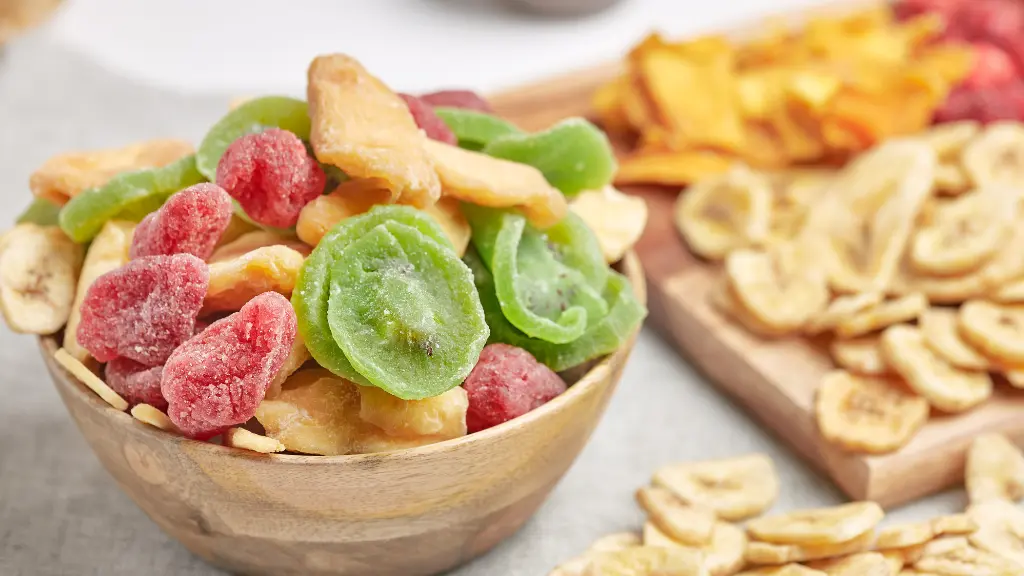Dried fruits have long been cherished for their rich flavors and nutritional value. They are a convenient way to enjoy fruit on the go while reaping various health benefits. With their long shelf life and versatility, dried fruits are a must-have in every pantry.
Let’s dive into the world of dried fruits and discover why they deserve the spotlight this month.
You May Also Like: Seaweed: A Tasty, Nutritious Snack
1. What Are Dried Fruits?
Dried fruits are fresh fruits with most of their water content removed through drying processes such as sun-drying or using dehydrators. This concentrates their nutrients and natural sugars, giving them a sweeter taste and chewy texture.
Popular dried fruits include raisins, apricots, dates, figs, prunes, and dried mango.
2. Nutritional Benefits of Dried Fruits
Dried fruits are small but mighty when it comes to nutrition.
Packed with Nutrients:
- Vitamins: Dried fruits retain many vitamins from their fresh counterparts, like vitamin A, vitamin C, and B-complex vitamins.
- Minerals: They are rich in potassium, magnesium, and iron, essential for energy and overall health.
- Fiber: High in fiber, they promote digestive health and help maintain a healthy weight.
- Antioxidants: Dried fruits like apricots and raisins contain antioxidants that protect cells from damage.
Energy Boost:
Dried fruits are a quick source of energy, making them a favorite among athletes and active individuals.
3. Health Benefits of Dried Fruits
a. Supports Heart Health
Dried fruits like apricots and raisins are rich in potassium, which helps regulate blood pressure. They also contain soluble fiber that lowers bad cholesterol.
b. Enhances Digestion
Prunes are famous for relieving constipation due to their high fiber content and natural laxative properties.
c. Boosts Immunity
Figs and dates are loaded with antioxidants that strengthen the immune system and fight infections.
d. Improves Bone Health
Dried fruits like figs are high in calcium, which supports strong bones and teeth.
e. Aids Weight Management
The fiber in dried fruits keeps you feeling full longer, reducing cravings and supporting weight loss goals.
4. Popular Types of Dried Fruits
Each dried fruit has unique flavors and health benefits.
a. Raisins
- Made from dried grapes.
- Great for heart health and digestion.
b. Dates
- Sweet and chewy.
- Packed with energy, potassium, and magnesium.
c. Apricots
- Vibrant orange and tangy.
- High in vitamin A and antioxidants.
d. Figs
- Soft and sweet with seeds.
- Rich in calcium and fiber.
e. Prunes
- Dried plums known for digestive benefits.
f. Dried Cranberries
- Tart and sweet.
- Loaded with antioxidants that promote urinary tract health.
g. Dried Mango
- Tropical and flavorful.
- High in vitamins A and C.
5. How to Enjoy Dried Fruits
Dried fruits are incredibly versatile and can be incorporated into various dishes.
a. Snacking
Enjoy them straight out of the bag as a healthy snack.
b. Baking
Add dried fruits like raisins, dates, and cranberries to cookies, muffins, and cakes.
c. Salads
Sprinkle dried fruits on salads for a burst of flavor and texture.
d. Trail Mix
Combine dried fruits with nuts and seeds for a homemade trail mix.
e. Breakfast Toppings
Top oatmeal, yogurt, or smoothie bowls with dried fruits for added sweetness and nutrients.
f. Savory Dishes
Use dried fruits in dishes like pilafs, tagines, or stuffings to add depth and sweetness.
6. Dried Fruits vs. Fresh Fruits
While dried fruits offer concentrated nutrients, they are also higher in sugar and calories per serving than fresh fruits. Moderation is key to enjoying their benefits without overloading on calories.
Tips for Portion Control:
- Stick to a small handful (about ¼ cup) as a serving.
- Balance dried fruits with nuts or whole grains to stabilize blood sugar levels.
7. Potential Concerns and Solutions
a. High Sugar Content
Some dried fruits are sweetened with added sugar. Choose unsweetened or naturally dried options.
b. Sulfites in Dried Fruits
Sulfur dioxide is often used to preserve the color of dried fruits like apricots. Look for organic or sulfite-free options if you’re sensitive to additives.
c. Overeating Risk
Their small size and sweet flavor can lead to overeating. Stick to measured portions.
8. How to Select and Store Dried Fruits
Choosing Quality Dried Fruits:
- Opt for organic, unsweetened varieties.
- Check the ingredient list for minimal additives.
Storage Tips:
- Keep dried fruits in an airtight container in a cool, dry place.
- Refrigerate them for a longer shelf life.
9. Homemade Dried Fruits
Making dried fruits at home is easy and ensures they are free from additives.
Steps:
- Slice fresh fruits into thin pieces.
- Arrange them on a baking sheet lined with parchment paper.
- Dry them in an oven at the lowest temperature or use a food dehydrator.
- Store in airtight containers once completely dried.
10. Why Dried Fruits Are a Smart Snack Choice
Dried fruits are not just tasty but also incredibly convenient. They’re lightweight, non-perishable, and packed with nutrients, making them perfect for busy lifestyles.
Whether you’re looking for a quick snack, a meal enhancer, or a natural sweetener, dried fruits have you covered.
Conclusion
Dried fruits are the perfect blend of taste, nutrition, and convenience. From boosting heart health to aiding digestion, they offer a plethora of benefits. Their versatility ensures you can enjoy them in countless ways.
Make dried fruits a part of your daily diet to enjoy their delicious flavor and amazing health benefits. Snack smart and live healthily!



One thought on “Fruit of the Month: Dried Fruits”